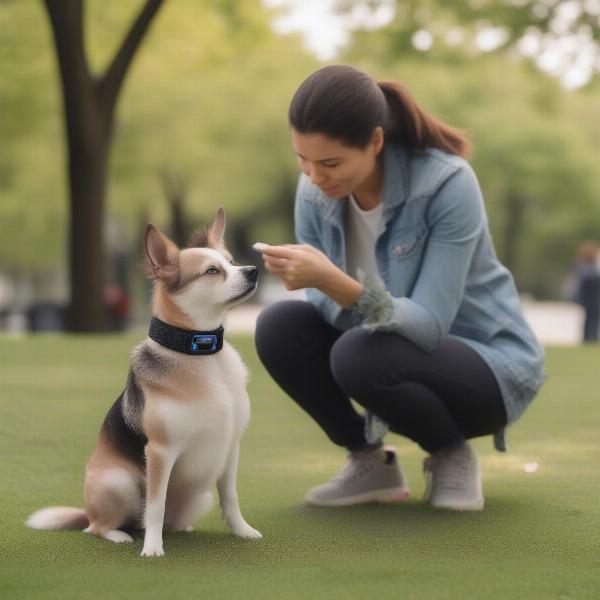Remote control bark collars for small dogs are a popular training tool, but they come with both advantages and disadvantages. Understanding how these devices work, their potential benefits, and the ethical considerations involved is crucial for responsible pet ownership. This guide provides a comprehensive overview of remote training collars, helping you decide if they’re the right choice for your small breed companion.
Understanding Remote Control Bark Collars
Remote control bark collars are designed to interrupt unwanted barking behavior. They work by emitting a stimulus when your dog barks, which can be a vibration, a spray of citronella, or a static correction. The remote control allows you to deliver the stimulus at the exact moment the barking occurs, aiding in the timing crucial for effective training.
Types of Remote Control Bark Collars
There are several types of remote training collars available, each using a different stimulus:
- Vibration Collars: These collars deliver a vibrating pulse to interrupt barking. This is often a good starting point for sensitive or smaller dogs.
- Citronella Spray Collars: These collars emit a harmless spray of citronella when the dog barks. The scent is unpleasant for dogs, deterring them from barking.
- Static Correction Collars: These collars deliver a mild static pulse, similar to the sensation of touching a statically charged doorknob. These should only be used as a last resort and under the guidance of a professional trainer.
Choosing the Right Collar for Your Small Dog
When choosing a remote bark collar for a small dog, consider the following factors:
- Size and Breed: Ensure the collar fits your dog comfortably and securely. Collars designed for smaller breeds are generally lighter and have adjustable straps.
- Temperament: A sensitive dog might respond better to vibration or citronella, while a more stubborn dog might require static correction (under professional guidance).
- Barking Trigger: Identify what triggers your dog’s barking. Is it boredom, anxiety, or territorial behavior? This will help you determine the best training approach.
Training with a Remote Control Bark Collar
Using a remote control bark collar effectively requires patience and consistency. Here’s a step-by-step guide:
- Introduce the Collar Gradually: Let your dog get used to wearing the collar before activating the stimulus.
- Timing is Key: Deliver the stimulus immediately after the bark. This helps your dog associate the correction with the unwanted behavior.
- Positive Reinforcement: Combine the collar with positive reinforcement techniques like praise and treats. Reward your dog for quiet behavior.
- Consistency: Use the collar consistently every time your dog barks excessively. Inconsistency will confuse your dog and hinder the training process.
- Seek Professional Guidance: If you’re unsure about using a remote control bark collar, consult a certified dog trainer. They can provide personalized guidance and ensure you’re using the device safely and effectively.
Are Remote Control Bark Collars Cruel?
This is a common concern among dog owners. When used responsibly and under the guidance of a professional, remote control bark collars can be a humane training tool. training collar for small dog However, misuse can lead to stress and anxiety in dogs. It’s essential to prioritize positive reinforcement methods and avoid using the collar as a punishment.
“Remote training collars, when used correctly, can be a valuable tool for addressing nuisance barking. However, it’s crucial to prioritize positive reinforcement methods and avoid using the collar as a form of punishment.” – Dr. Emily Carter, DVM
 Dog training with a remote control bark collar
Dog training with a remote control bark collar
Conclusion
Remote control bark collars for small dogs can be an effective training aid when used correctly. By understanding the different types of collars, choosing the right one for your dog, and following a consistent training approach, you can help your small dog learn to bark less excessively. Always prioritize your dog’s well-being and consult a professional if needed. Remember, a well-trained dog is a happy dog.
FAQ
- Are remote control bark collars safe for small dogs? Yes, when used responsibly and with the appropriate settings for your dog’s size and temperament.
- What type of remote control bark collar is best for a sensitive small dog? A vibration collar or a citronella spray collar is typically a good starting point for sensitive dogs.
- How long does it take to train a dog with a remote control bark collar? The training timeframe varies depending on the dog’s temperament and consistency in training.
- Can I use a remote control bark collar on a puppy? Consult your veterinarian before using any training collar on a puppy.
- What if my dog’s barking doesn’t improve with a remote control bark collar? Consider consulting a professional dog trainer to address the underlying cause of the barking and explore alternative training methods.
- Are there any alternatives to remote control bark collars? Yes, alternatives include positive reinforcement training, desensitization techniques, and anti-bark devices like ultrasonic bark deterrents.
- Can I use the remote control bark collar for other training purposes? It’s best to use the collar specifically for barking control. For other training needs, explore dedicated training tools and techniques.
Related Articles
ILM Dog is your trusted international resource for all things dog-related. We provide expert guidance on dog breeds, health care, training, nutrition, grooming, and much more. Whether you’re a seasoned dog owner or just starting your journey, ILM Dog is here to help you provide the best possible care for your canine companion. Our expertise in Dog Breeds and Selection, Training and Behavior, and Products and Accessories ensures you have the resources to make informed decisions. Contact us at [email protected] or call +44 20-3965-8624 for personalized advice.